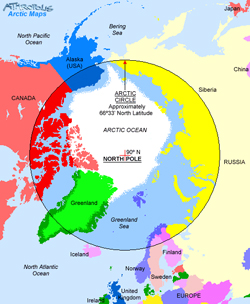August 28thAs our departure to Barrow, Alaska to join the Coast Guard icebreaker Healy draws near, I daydream about the maritime Arctic. My experience is tiny compared our chief scientist’s, Bob Pickart. He’s been numerous times to the hard waters east of Greenland, the Labrador Sea in winter, and aboard Healy in the Beaufort. But I’ve seen enough aboard various vessels to understand that these waters are unique in the world. The strange, disorienting light and unlimited visibility, the iron-clad wind, the ice in all its forms, the profusion of wildlife—once witnessed, the Arctic reaches out to grab one’s sensibility and imagination and never lets go. I’m longing to see it again from deck level. But before we get there, we should probably ask the question, “Just what is the ‘Arctic’? What are its boundaries?” The answer isn’t straightforward. How about the Arctic Circle, 66 degrees 33 minutes North latitude, as a boundary? Everything north of the Arctic Circle is the Arctic, and everything south of it is not. (There are 60 nautical miles in one degree of latitude. The equator is designated zero degrees, and the North Pole 90 degrees North latitude. Therefore, the diameter of the Arctic Circle is 1,420 nautical miles south of the North Pole.) That’s neat, mathematical, but it doesn’t exactly work. The Arctic Circle excludes places that are definitely “arctic” in nature, including Hudson Bay, Labrador, and parts of Siberia. Well then, let’s try an “ecological border” the “timberline,” where the forest gives way to flat, treeless tundra. This border coincides roughly with the so-called 10-degree C. isotherm (50 degrees F.), an irregular zone where the temperature in the warmest month, usually July, reaches 10 degrees Celsius. But the treeline wavers. In some places such as northern Canada and Siberia trees give up well south of the Arctic Circle, and in others such as Scandinavia they reach north of the circle. This border may be helpful to botanists and biologists, but the treeline or the 10-degree isotherm is of little use to oceanographers. The Arctic Ocean is a frozen sea surrounded—and almost enclosed—by continents (conversely, the Antarctic is a frozen continent surrounded by ocean). There is, then, a maritime Arctic and a terrestrial Arctic. And that’s part of the problem in determining just what is Arctic and what is subarctic. To put a boundary to the maritime Arctic is also problematical. We aboard Healy are primarily studying the Beaufort Sea. If we were to sail west (clockwise) around the rims of the surrounding continents, we would pass through the Chukchi, East Siberian, Laptev, Kara, Barents, and Greenland seas before returning to the Beaufort Sea. So from a strictly maritime perspective, the Arctic consists of an ocean surrounded by seas. Yet the borders between the seas are determined by international politics, not nature. For instance we are usually prohibited by Russia to poke our bows into “their” part of the Chukchi Sea even for peaceful scientific purposes. Then where do the northern reaches of all these seas give way to the southern fringes of Arctic Ocean? For convenience, ocean scientists generally agree that the Arctic Ocean is the part of the basin that remains more or less permanently covered by ice, an area of some 5.66 million square miles. In summer ice generally retreats from the surrounding seas. We humans need names for things, particularly big geographic features, just as we need names for each other. But the Arctic doesn’t cooperate by being one thing, one place. And that’s the important point for us. The Arctic, no matter where we draw its borders, will include land, ocean—and ice. And that’s why Dr. Bob has conceived this expedition to include a range of scientific disciplines. No one discipline (biology, physics, meteorology, oceanography) can grasp completely the condition and dynamics of Arctic climate. That takes a scientific team. And as the expedition progresses, we’ll talk with each of the scientists about their objectives and methods, intending by its close to develop a firmer sense of the whole. But at this remove of several days and thousands of miles, I’m not thinking about the Arctic in scientific terms. Rather, I’m remembering the sheer beauty of the place, the colors of the sky and ocean, now hard, ominous, grey, then friendly, blue and ethereal 30 minutes later. I’m remembering the Northern Lights shimmering and shifting, the strange tricks played on our eyes, the sundogs, the mirages, by an atmosphere suffused with ice crystals; and the birds and animals; and the ice, always the ice. Arguably, we Westerners see environments in dual but not necessarily exclusive terms. The scientist asks, what and why questions about nature; he or she probes and measures to answer them, while the romantic focuses on the aesthetics of the environment, on the evocative nature of its beauty. We’ll try for both. But there is another view, that of the native Inupiat, who see the Northern Lights not as electromagnetic particles from the sun colliding in the ionosphere, but as the gift of light from the dead to those on earth to brighten the gloom of winter. We’ll try our best to understand their view of their environment. It too is the Arctic. Last updated: September 28, 2010 | |||||||||||||||||||
Copyright ©2007 Woods Hole Oceanographic Institution, All Rights Reserved, Privacy Policy. | |||||||||||||||||||

